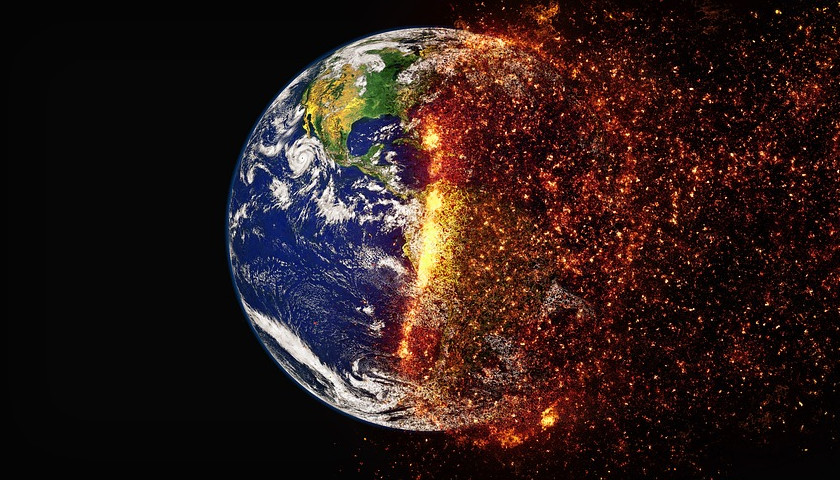by David M. Simon
The “experts” that dominate government, big business, universities, and international institutions vitriolically insist that “science” purportedly establishes beyond doubt that carbon dioxide emissions are raising global temperatures and that the warmer earth will be catastrophic.
In 2020, the pandemic-induced shutdowns that inflicted so much economic harm, particularly on the Third World’s already poor, reduced CO2 emissions by a record-breaking 7 percent. Those demanding that Americans reduce emissions must be especially pleased: the U.S. led the world with a 12 percent reduction.
Prevailing scientific orthodoxy dictates that lowering CO2 emissions will restrain global warming. Yet NASA data show that the planet’s temperature increased by 0.03 degrees Celsius in 2020, more than double the average annual increase since 1920.
So much for the supposedly conclusive “scientific” link between CO2 emissions and global warming. Yet demands to reduce CO2 emissions continue unabated. Their insistence that we accept a theory contradicted by facts disregards basic scientific principles, fails to “follow the science,” and instead reflects religious views about the earth’s climate.
The assertion that reducing CO2 emissions will limit the planet’s warming isn’t the worst of the anti-scientific claims that dominate the climate change debate. That honor goes to the assertion that global warming is harmful and will be catastrophic. The scientific evidence contradicts this theory and shows the opposite: a warmer earth is beneficial.
A 2017 statement by some of the world’s most eminent scientists – such as Richard Lindzen of MIT, William Happer and the late Freeman Dyson of Princeton, the late Fred Singer of the University of Virginia, and Judith Curry of Georgia Tech – attests that “[o]bservations [over the last] 25 years … show that warming from increased atmospheric CO2 will be benign.”
Their statement notes that “carbon dioxide … is not a pollutant but a major benefit to agriculture and other life on Earth.” The dry ice used to keep the coronavirus vaccines cool, indeed, is solid frozen CO2.
Perhaps the strongest evidence that global warming is beneficial rather than harmful was published by the British medical journal The Lancet in 2015. This study by 22 scientists from around the world found that cold kills over 17 times more people than heat.
The scientists examined over 74 million deaths in Australia, Brazil, Canada, China, Italy, Japan, South Korea, Spain, Sweden, Taiwan, Thailand, the United Kingdom, and the United States in 1985-2012. They found that cold caused 7.29 percent of these deaths, while heat caused only 0.42 percent.
And small temperature changes are particularly significant. The study found that “moderately hot and cold temperatures” caused 88.85 percent of the temperature-related deaths, while “extreme” temperatures caused only 11.15 percent.
The data also show that global warming over the last one hundred years has neither increased harm from natural disasters nor prevented dramatic economic growth that has lifted billions out of poverty.
Natural disaster data compiled by EM-DAT (The International Disaster Database), indeed, show the opposite: since 1920, as the earth has warmed by 1.29 degrees – and as world population has quadrupled from less than two billion to over seven and half billion – the number of people killed by natural disasters has declined by over 80 percent, from almost 55,000 per year to less than 10,000 per year.
Air pollution data compiled by University of Oxford economist Max Roser and researcher Hannah Ritchie also are encouraging. Since 1990, while the planet’s temperature has risen by 0.57 degrees, the global air pollution death rate has declined by almost 50 percent, from 111.28 to 63.82 deaths per 100,000 people.
The economic data are even more positive. Oxford’s Roser also has reported that since 1920, as planet’s temperature has risen, the share of people living in extreme poverty fell from 67 percent in 1950 to less than 10 percent by 2015.
But what of the supposedly fast approaching catastrophic harm to the world economy? A 2019 National Bureau of Economic Research study suggests that it will be minimal.
Since 1960, as the earth has warmed by 1.05 degrees, global income per person has skyrocketed from $452 to $11,436 in 2019, according to World Bank data compiled by Macrotrends. That reflects a growth rate of over 5.6 percent per year.
If over the next 80 years, global income per person increases at just one fourth of that rate, i.e., at 1.4 percent per year, it will reach $34,778 in 2100.
The 2019 NBER study estimated that if the earth’s temperature rises by 0.01 degrees per year through 2100, world GDP in 2100 will be 1.07 percent lower in 2100 than it would otherwise be. This would reduce income per person from $34,778 to $34,406.
Even NBER’s extreme case projection that world GDP will be 7.22 percent lower in 2100 than it would otherwise be if the planet’s temperature rises by 0.04 degrees per year (over three times the actual rate of increase since 1920) similarly would leave income per person at $32,267.
In other words, regardless of any negative impact that global warming may have, world income per person in 2100 would be about three times today’s level.
The bottom line is that the case to limit CO2 emissions and global warming fails the most basic tests of sound science.
– – –
David M. Simon is a senior fellow at the Committee to Unleash Prosperity and a lawyer in Chicago. For more, please see www.dmswritings.com.




